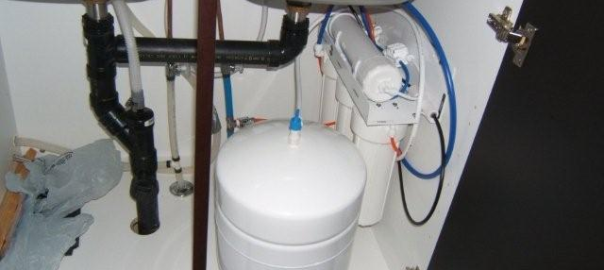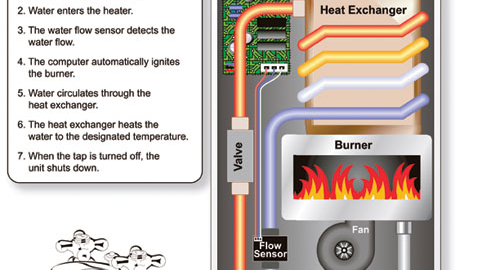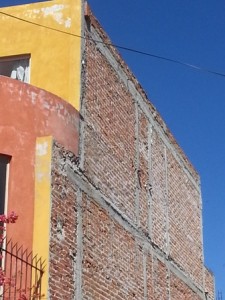
Monthly Archives: February 2016


On Demand Hot Water Heaters, Save Energy or Save Water
Here in San Miguel, sometimes the flow rate on your shower heads and faucets isn’t enough to keep your on-demand heater on and thus allowing “slugs” of cold water to enter the system. If you are handy you can choose to use more water by removing the constrictors in the shower heads and drilling a small hole (when necessary) in the orifice to increase the flow rate so your on demand heater doesn’t keep turning itself off thus allowing the cold water to enter the line. If your pressure is a bit low (you are up high in the house and you have a gravity feed tinaco without a pressure boost pump) then you may be signing up for frustration with an on-demand heater.
Solar preheaters save energy and can work with a wider range of pressures. It is a great combination and will reduce your propane gas consumption.
I have heard from enough owners and plumbers on this subject to say that in San Miguel de Allende you need to check your system carefully before installing an on demand heater:
- Do you have a 3/4″ gas supply line from your propane tank to the heater (needed for a 185,000 btu heater)? Long distances from your water tank (tinaco) to the heater may cause insufficient flow and tempermental heating if your line is the typical 1/2 inch copper. A recommended minimum heater size of 185,000 btu’s needs a good flow rate from the propane tank.
- Do you rely on street pressure to fill your water tank (cistern or rooftop tinaco)? Some houses have no cistern and no pressure pump. So they are stuck with gravity pressure from the rooftop tinaco. This means low pressure on the top floor to showers which improves as you go down to lower floors in the house. On demand heaters need a minimum flow rate of around 7/10 gallon per minute. You can test this by just running your hose or shower into a bucket for one minute.
- Do you have a boost pump to increase water pressure to your water lines, filtration system etc? Do you have good pressure everywhere in the house?
- Will you calculate your high or peak demand useage to correctly choose your heater size and does this demand match the delivery rate capacity of your water line (1/2 inch lines with rooftop pressure may not be enough unless your tinaco is perhaps 2 to 3 floors above the heater)
- Does your filtration system (whole house type) maintain enough pressure to avoid cold water “slugs”?
I cannot improve upon David Grubbs information on tankless hotwater heaters here.

Water and Moisture
Keeping water outside the house, preventing it from coming in through the roof, walls, floors, doors and windows can be a challenge when you have the kind of hard rains we have here in San Miguel. Many homes do not use thresholds and weather-stripping at the doors so windblown rain can really come in fast.
MOISTURE IN THE WALLS
More frustrating is the infiltration of moisture through walls, ceilings and floors. The problem is finding the source of moisture which may not be on your property. The water can be traveling through the soil or through other house walls for very long distances. The only protection you have is to put waterproofing coatings on the outside of your foundations, floors and walls. If you have buildings up against your walls then generally you are stuck with the problem unless you can excavate on both sides of the wall and foundation and this is most often not possible. There are some coatings that can go on the inside of the walls and floors, there are French drains and vent holes that can be added but all of these options are almost never 100 percent effective and the moisture usually returns at the same spot or someplace nearby as the moisture finds the easiest path to escape.
Despite these well known infiltration problems, builders and architects continue to build foundations and stem walls without proper damp proofing (or none at all). If you already own a home and there is an empty lot or a garden next to your exterior walls, before the access is permanently blocked, put on a waterproofing membrane (better than a coating) and install French drains if you can slope the drain to daylight (if not, all you are doing is creating an underground pond for water to collect and eventually enter your house). Many architects and builders need better specifications and installation practices. Asphalt/bitumen based “roof coating” rolled or brushed on is helpful but the current standard (of course I am talking about the U.S.) is a membrane that combines these materials with polymers in a tuff sheet sold in rolls that can be torched on or self adhered. Bitumen or asphalt based brush on coatings (impermeabilizantes) are better than nothing but if you can access the lower walls and foundations then I recommend spending the money to install a membrane. As coatings get more sophisticated (polyurethanes etc) they become more effective. Wikipedia has a decent discussion of “waterproofing” and “dampproofing” that is helpful.
EXISTING HOMES
DOORS AND WINDOWS
I came home one night to my recently rented house during a hard rain and found a cascade coming down the stairs. The wind direction was just right to maximize the amount of rain getting in under the unprotected terrace doors and the terrace drain was partially blocked by leaves and debris. So we adapted the door sweeps which stopped the main flow but we still need a towel on the floor during certain storms. Good thing we have Saltillo tile floors.
First, if it isn’t too late, put in thresholds on the unprotected exterior doors, the ones that are not under a portal (yes, I know this changes the “feel” of how the indoor and outdoor space flows). Next, add door sweeps with flexible weather stripping on the bottom to minimize water infiltration. Some rain will still get in if you have French doors. In a perfect world, French doors belong under protective overhangs and portals.
UNFINISHED SIDE WALLS
Second, are the sides and back of your house plastered or raw brick ? It is common here to wait for your neighbor to finish their house and cover up the unfinished sides of your home. This is one of my “pet peeves” about builders and developers here in San Miguel. If you cannot afford it then okay, you have to wait. But if you can you should at least plaster one coat and throw on a coat of paint that matches your other elevations. If you don’t, hard rains may enter and damage the plaster and paint on the inside of those walls. Here is an unfinished wall with no moisture problems inside perhaps because it faces east. The other west wall had to be plastered to stop the moisture damage. Note the white paint could have been tinted to be more like the house. It was a pretty quick fix. Note the white efflorescing below the parapets. More on that in another post.


HEALTH CONCERNS
Moisture in walls grows mold. I have done many mold inspections in San Miguel and in the U.S. I have yet to find dangerous black mold (stachyboris) and asperguilias here in San Miguel. But as I learned from clients here, any mold can be harmful to a person with sensitivities, allergies or with compromised immune systems. See more in the “harmful mold” post http://smahomeinspections.com/blog/2016/03/17/do-you-have-dangerous-mold/ .

Electrical Service and Circuit Panel
YOUR SERVICE. Your electric service probably starts on the street where the CFE poles and electric lines are located. There is a “drop” to your house, usually two cables to a masthead then down the pipe/wall to your meter (mechanical ones spin, newer digital with readout only). From the meter it usually goes through the wall into your garage, house, entry or some other space where it often stops at a “main breaker” which tells you how much service you have (usually but not always). Larger modern houses with hot tubs, electric heaters, electric clothes dryers, cooktops etc need a 200 amp service but a lot of homes in San Miguel have 50/60 amp to perhaps 100 amp sercvice.
YOUR PANEL. First, know where your panel is so if you have a power outage you can check and make sure you didn’t just trip a breaker. 50/60 amp services often have 8 circuits like the one shown. 100 amp service often have 16 circuits. Outlets/receptacles should be 20 amp with 12 gauge copper wire, lights 15 amp with 14 gauge copper and equipment such as a 220V oven should have larger circuit breakers sized to protect the wire and appliance they serve.
In another post I will give you a few simple trouble shooting techniques to help when there’s a problem. “Hey, what’s that smaller boxy thing to the left of the panel…..?” More on surge protectors in another post.